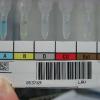Reputation Activity
-
 Dansket got a reaction from David Saikin in positive dat w cord blood
Dansket got a reaction from David Saikin in positive dat w cord blood
An important aspect of this conundrum to remember is that physicians do not treat newborns just because of a positive DAT, they treat infants who are anemic or hyperbilirubinemic regardless of the DAT results.
-
 Dansket got a reaction from David Saikin in Daily QC for ABO Reagents
Dansket got a reaction from David Saikin in Daily QC for ABO Reagents
Automated Gel and Manual Gel are two different methods each method requiring Daily/Day of Use QC. For these reasons, running a positive and negative DAT would suffice only for DAT testing that day, but not for any other test run by Manual Gel.
-
 Dansket got a reaction from dcubed in anti-Lewis a,b
Dansket got a reaction from dcubed in anti-Lewis a,b
If current antibody screen is positive and Lewis antibody identified, do immediate-spin and anti-igG crossmatches, issue crossmatch-compatible random donor units. If current antibody screen is negative and there is a history of Lewis antibody, do Computer Crossmatch with random donor units.
-
 Dansket reacted to TreeMoss in Typenex Bands: Should They Stay or Should they Go?
Dansket reacted to TreeMoss in Typenex Bands: Should They Stay or Should they Go?
Our facility uses MobiLab. This system prints labels after scanning the patient identification band. The specimens are then labeled at the patient bedside when collected. We have Meditech that uses Bar-coded Transfusion Administration. Nurses scan the patient ID band and unit identifiers (DIN, Product, and Blood Type barcode labels). If something doesn't match, an error message pops up to return the product to the blood bank. This system is used for all transfusions except some emergencies (i.e., Massive Transfusion Protocols). It works very well.
In the past, we used Biologics wristband label with patient ID. These worked like a credit card -- labels were made from embossed plates and attached to specimens -- so I've never used the Typenex bands. With the Biologics and now our current wristbands, we are able to use the blood specimens that were collected previously for CBCs, etc., for our blood bank work if the specimens were labeled with MobiLab. There was no reason to have to stick the patient again for a blood bank specimen. This system works.
-
 Dansket got a reaction from frenchie in Rh negative Patients that receive Rh positive blood
Dansket got a reaction from frenchie in Rh negative Patients that receive Rh positive blood
See this large study https://www.ncbi.nlm.nih.gov/pubmed/3137672 regarding use of rh positive blood for untyped trauma recipients.
Abstract
The emergency blood needs of 449 patients were met by supplying 1,717 uncrossmatched units of either red blood cells (RBC) type specific Whole Blood or group O RBC. The RBC were all Rh positive, and 601 units were transfused to 262 untyped patients. None of the patients presented with anti-Rh antibodies. Only 20 patients who were Rh negative received group O Rh positive RBC, and most of these patients were male. There were no acute hemolytic reactions or sensitizations of young females. Group O Rh positive RBC is our first choice to support patients with trauma who cannot wait for type specific or crossmatched blood. Those who do survive the emergency conditions can be reverted to blood of their own type without problem. Acceptance of Rh positive emergency transfusions by physicians giving emergency care can prevent unbalanced shortages in a regional blood supply system.
-
 Dansket got a reaction from cthherbal in 2nd ABO
Dansket got a reaction from cthherbal in 2nd ABO
Do the UK guidelines state how the second sample should be tested for ABO? If so, which tests are required?
In the US, for the second ABO when Computer Crossmatch is done, the AABB currently requires both red cells and plasma/serum be tested and the CAP does not specify required testing for ABO Confirmation (red cells and plasma/serum, red cells only or plasma/serum only).
-
 Dansket reacted to David Saikin in Passive ABO antibodies in Emergency release blood
Dansket reacted to David Saikin in Passive ABO antibodies in Emergency release blood
Have never had to do that (from 24 bed to 700+ hospitals)
-
 Dansket reacted to Malcolm Needs in Passive ABO antibodies in Emergency release blood
Dansket reacted to Malcolm Needs in Passive ABO antibodies in Emergency release blood
In the UK, the Guidelines say to swap to the patient's own blood group as soon as it is definitely ascertained, with no testing, whatever they have been given; it works.
-
 Dansket reacted to SMILLER in Direct entry of manual testing results into LIS
Dansket reacted to SMILLER in Direct entry of manual testing results into LIS
We went through this a few years ago. The problem with any kind of written worksheet is that it becomes your primary record -- the computer entry is secondary. -- resulting in both sets of records must be retained. When results are directly entered into the computer, almost all written testing records are not needed.
Scott
-
 Dansket reacted to carolyn swickard in Direct entry of manual testing results into LIS
Dansket reacted to carolyn swickard in Direct entry of manual testing results into LIS
The really important point is that they enter their data into the computer directly from the test media or instrument printout (in our case). No results from memory or their own interpretation of the results (i.e. "it was an O Pos - I'll just make it an O pos"). That is the real battle.
-
 Dansket reacted to David Saikin in Direct entry of manual testing results into LIS
Dansket reacted to David Saikin in Direct entry of manual testing results into LIS
Stop using paper once you have your BBIS validated. It is just as easy to type 4 as to write 4+.
The system shouldn't let you make interpretation errors. Trust it.
I know I've been turned down for positions because I told the technical staff that their papers would be history from my day 1.
I also have inspected places that did the paper first. Went to watch a transfusion and had to return because the patient needed irradiated products - only found in the computer. It was a good lesson that you don't want repeated when you get inspected.
-
 Dansket reacted to John C. Staley in Direct entry of manual testing results into LIS
Dansket reacted to John C. Staley in Direct entry of manual testing results into LIS
I'm with David on this one. Doing both paper and computer entry just adds one more opportunity for mistakes. If you can't trust some one to put it in the computer correctly how can you trust them to write it down correctly! The key is the ability to enter the results as they see them and not have to walk over to a computer station to do it. Also, if you are entering from an instrument print out I highly suggest you get that instrument interfaced as quickly as possible. Again, you are entering results from paper and that should be avoided.
-
 Dansket got a reaction from AB123 in Titre Value
Dansket got a reaction from AB123 in Titre Value
We use a titer value of 0 (zero) to indicate absence of agglutination or less than 1+ agglutination in any tube.
-
 Dansket got a reaction from jojo808 in 2nd ABO
Dansket got a reaction from jojo808 in 2nd ABO
Your post suggests that patients who initially type group O should be tested a second time for not only ABO, but also Rh and Antibody Screen. I assume you would include the same testing (ABO, Rh and Antibody Screen) for non-Group O patients. I disagree.
Does anyone (US and UK) in this forum repeat the Antibody screen on the same sample or a newly collected blood sample? Repeat the Rh?
The concept of a second ABO typing did not emerge until after the "Computer Crossmatch" became an alternative method (to the serological crossmatch) approved by the FDA in the late 1990’s. Repeat testing of the same sample or a newly collected blood sample for Rh and Antibody screen was not required by the FDA, AABB or the CAP.
A second ABO typing is intended to be a serological alternative to the Immediate-spin Crossmatch to confirm the patient's ABO determination when a "Computer Crossmatch" is done. This creates a process that is similar to that done for donor units, i.e., blood type determination by donor center and blood type confirmation by the Transfusion Service.
In the absence of a "Computer Crossmatch", a serological Immediate-spin Crossmatch is required to detect ABO incompatibility between donor and recipient and most patients are transfused based on a single ABO determination without any repeat testing for Rh or Antibody Screen.
-
 Dansket got a reaction from tkakin in 2nd ABO
Dansket got a reaction from tkakin in 2nd ABO
Testing the same specimen twice may detect some internal testing errors, but will not detect WBIT (Wrong Blood In Tube).
You need to gather some data to show how many patients would be impacted by collecting a second blood sample.
Ask these questions, "How many patient admits annually?", "How many patient admits required blood bank testing?" (at my facility the calculated percentage was 11%), "How many patient samples type as Group O?" (at my facility the calculated percentage was 55% and we don't draw a second blood sample on these patients), "Of the non-Group O patients, how many had an independently collected blood sample in Hematology that could be used for the second ABO blood sample" (in our facility that was calculated to be 16%).
So for every 1000 patients admitted annually, 100 (I'm using 10% for sake of simple calculations) would require blood bank testing of whom 45 (100-55) would be non-group O, 7 (45 x 0.16) would have a blood sample in hematology, leaving 38 (45 - 7) or 3.8% (38/1000) patients requiring a second sample to be collected.
Using this kind of data will give you a much better grasp of the impact of routine performance of a second ABO determination on all patients for whom a Type and Screen or a Type and Crossmatch is ordered.
-
 Dansket got a reaction from AMcCord in Rh negative Patients that receive Rh positive blood
Dansket got a reaction from AMcCord in Rh negative Patients that receive Rh positive blood
See this large study https://www.ncbi.nlm.nih.gov/pubmed/3137672 regarding use of rh positive blood for untyped trauma recipients.
Abstract
The emergency blood needs of 449 patients were met by supplying 1,717 uncrossmatched units of either red blood cells (RBC) type specific Whole Blood or group O RBC. The RBC were all Rh positive, and 601 units were transfused to 262 untyped patients. None of the patients presented with anti-Rh antibodies. Only 20 patients who were Rh negative received group O Rh positive RBC, and most of these patients were male. There were no acute hemolytic reactions or sensitizations of young females. Group O Rh positive RBC is our first choice to support patients with trauma who cannot wait for type specific or crossmatched blood. Those who do survive the emergency conditions can be reverted to blood of their own type without problem. Acceptance of Rh positive emergency transfusions by physicians giving emergency care can prevent unbalanced shortages in a regional blood supply system.
-
 Dansket reacted to Ward_X in Give E and c negative units?
Dansket reacted to Ward_X in Give E and c negative units?
Just from a man-power standpoint, you don't always have the time to "extra" antigen type. I've seen pts with anti-E that receive products on a weekly basis (that happen to be cancer pts) that have yet to make the anti-c. What about the extended billing for antigen typing? It just seems like a gross assumption to believe a pt with an anti-E acquiring a unit of red blood cells will form an anti-c from it (going back to Malcolm, who initially replied that the anti-E could have been made for reasons other than transfusion). I agree with the serological science of why these are seen together, and why the anti-E can lead to the anti-c, but I have trouble justifying the cost of tech/time, reagents, and billing, to go off a hunch that the anti-c is probable.
-
 Dansket got a reaction from David Saikin in Rh negative Patients that receive Rh positive blood
Dansket got a reaction from David Saikin in Rh negative Patients that receive Rh positive blood
See this large study https://www.ncbi.nlm.nih.gov/pubmed/3137672 regarding use of rh positive blood for untyped trauma recipients.
Abstract
The emergency blood needs of 449 patients were met by supplying 1,717 uncrossmatched units of either red blood cells (RBC) type specific Whole Blood or group O RBC. The RBC were all Rh positive, and 601 units were transfused to 262 untyped patients. None of the patients presented with anti-Rh antibodies. Only 20 patients who were Rh negative received group O Rh positive RBC, and most of these patients were male. There were no acute hemolytic reactions or sensitizations of young females. Group O Rh positive RBC is our first choice to support patients with trauma who cannot wait for type specific or crossmatched blood. Those who do survive the emergency conditions can be reverted to blood of their own type without problem. Acceptance of Rh positive emergency transfusions by physicians giving emergency care can prevent unbalanced shortages in a regional blood supply system.
-
 Dansket reacted to Ward_X in Give E and c negative units?
Dansket reacted to Ward_X in Give E and c negative units?
Not all pts form antibodies each time they're transfused, and not against every antigen to which they are phenotypically negative. Futhermore, you wouldn't even know the pt is c= unless you phenotyped; otherwise, you would have only tested and found the anti-E at the time of workup, and stopped there.
What prevents you from matching units that are phenotypically matched, even just the Rh group? That would require the extra resources and tech power to antigen type units. If they only have the anti-E at the date of product order, I don't see why you'd need to tack on additional testing. My lab tries to avoid extra testing if not needed
-
 Dansket got a reaction from SMILLER in Rh negative Patients that receive Rh positive blood
Dansket got a reaction from SMILLER in Rh negative Patients that receive Rh positive blood
See this large study https://www.ncbi.nlm.nih.gov/pubmed/3137672 regarding use of rh positive blood for untyped trauma recipients.
Abstract
The emergency blood needs of 449 patients were met by supplying 1,717 uncrossmatched units of either red blood cells (RBC) type specific Whole Blood or group O RBC. The RBC were all Rh positive, and 601 units were transfused to 262 untyped patients. None of the patients presented with anti-Rh antibodies. Only 20 patients who were Rh negative received group O Rh positive RBC, and most of these patients were male. There were no acute hemolytic reactions or sensitizations of young females. Group O Rh positive RBC is our first choice to support patients with trauma who cannot wait for type specific or crossmatched blood. Those who do survive the emergency conditions can be reverted to blood of their own type without problem. Acceptance of Rh positive emergency transfusions by physicians giving emergency care can prevent unbalanced shortages in a regional blood supply system.
-
 Dansket got a reaction from John C. Staley in Rh negative Patients that receive Rh positive blood
Dansket got a reaction from John C. Staley in Rh negative Patients that receive Rh positive blood
See this large study https://www.ncbi.nlm.nih.gov/pubmed/3137672 regarding use of rh positive blood for untyped trauma recipients.
Abstract
The emergency blood needs of 449 patients were met by supplying 1,717 uncrossmatched units of either red blood cells (RBC) type specific Whole Blood or group O RBC. The RBC were all Rh positive, and 601 units were transfused to 262 untyped patients. None of the patients presented with anti-Rh antibodies. Only 20 patients who were Rh negative received group O Rh positive RBC, and most of these patients were male. There were no acute hemolytic reactions or sensitizations of young females. Group O Rh positive RBC is our first choice to support patients with trauma who cannot wait for type specific or crossmatched blood. Those who do survive the emergency conditions can be reverted to blood of their own type without problem. Acceptance of Rh positive emergency transfusions by physicians giving emergency care can prevent unbalanced shortages in a regional blood supply system.
-
 Dansket got a reaction from AMcCord in positive dat w cord blood
Dansket got a reaction from AMcCord in positive dat w cord blood
An important aspect of this conundrum to remember is that physicians do not treat newborns just because of a positive DAT, they treat infants who are anemic or hyperbilirubinemic regardless of the DAT results.
-
 Dansket got a reaction from Malcolm Needs in positive dat w cord blood
Dansket got a reaction from Malcolm Needs in positive dat w cord blood
An important aspect of this conundrum to remember is that physicians do not treat newborns just because of a positive DAT, they treat infants who are anemic or hyperbilirubinemic regardless of the DAT results.
-
 Dansket reacted to tbostock in Specimen Expiration
Dansket reacted to tbostock in Specimen Expiration
3rd day at midnight, with day of draw being day zero.
-
 Dansket got a reaction from AMcCord in Performing Antibody Screens As Part of RhIG Workups
Dansket got a reaction from AMcCord in Performing Antibody Screens As Part of RhIG Workups
Over the decades since Rh Immune Globulin became available and a standard for care in 1968, the guiding principle changed from 'looking for reasons not to give', i.e. withholding the injection versus currently 'looking for reasons to give'. Initially, the injection vial was packaged with a crossmatch vial that required a test tube crossmatch with the patient's rbcs. This was a safety step to address the concern of giving such a large volume (at that time I think it was 5ml in the US) of anti-D to an Rh positive individual.
Much later, it was determined that a second injection was required around 28 wks to prevent sensitization of women who might be hyper-responders.
Those safety concerns have been addressed with low volume (0.7ml), low protein formulations. Crossmatching is no longer required.
Performing an antibody screen with a workup is consistent with the original philosophy of 'looking for reasons to withhold the injection'.







